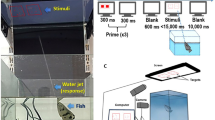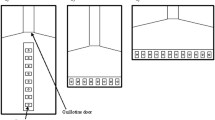Abstract
There is controversy in comparative psychology about whether on the one hand non-symbolic number estimation of small (≤4) and large numbers involves a single mechanism (an approximate number system), or whether on the other hand enumeration of the numbers 1–4 is accomplished by a separate mechanism, an object tracking system. To date, support for the latter hypothesis has come only from the different ratio-dependency of performance seen in the two numerical ranges, a reading that has been criticized on several grounds. In humans, the two-system hypothesis is supported by evidence showing that manipulation of the physical properties of the stimuli (e.g., the motion of the items) has dissimilar effects on small- and large-number discrimination. In this research, we studied this effect on guppies. Initially, fish were trained to simultaneously discriminate two numerical contrasts having the same easy ratio (0.50): one in the small-number (2 vs. 4) range and one in the large-number (6 vs. 12) range. Half of the fish were presented with moving items; the other half were shown the same stimuli without motion. Fish were then subjected to non-reinforced probe trials in the presence of a more difficult ratio (0.75: 3 vs. 4 and 9 vs. 12). Under both static and moving conditions, the fish significantly discriminated 6 versus 12, but not 9 versus 12 items. As regards small numbers, both groups learned to discriminate a 0.50 ratio, but only fish tested with moving stimuli also discriminated 3 and 4 items. This differential effect suggests that fish may possess two separate systems for small- and large-number discrimination.




Similar content being viewed by others
References
Agrillo C, Dadda M, Serena G (2008a) Choice of female groups by male mosquitofish (Gambusia holbrooki). Ethology 114(5):479–488
Agrillo C, Dadda M, Serena G, Bisazza A (2008b) Do fish count? Spontaneous discrimination of quantity in female mosquitofish. Anim Cogn 11:495–503
Agrillo C, Dadda M, Serena G, Bisazza A (2009) Use of number by fish. PLoS ONE 4(3):e4786
Agrillo C, Piffer L, Bisazza A (2010) Large number discrimination by fish. PLoS ONE 5(12):e15232
Agrillo C, Piffer L, Bisazza A (2011) Number versus continuous quantity in numerosity judgments by fish. Cognition 119:281–287
Agrillo C, Piffer L, Bisazza A, Butterworth B (2012a) Evidence for two numerical systems that are similar in humans and guppies. PLoS ONE 7(2):e31923
Agrillo C, Miletto Petrazzini ME, Piffer L, Dadda M, Bisazza A (2012b) A new training procedure for studying discrimination learning in fishes. Behav Brain Res 230:343–348
Agrillo C, Miletto Petrazzini ME, Tagliapietra C, Bisazza A (2012c) Inter-specific differences in numerical abilities among teleost fish. Front Psychol 3:483. doi:10.3389/fpsyg.2012.00483
Alston L, Humphreys GW (2004) Subitization and attentional engagement by transient stimuli. Spat Vis 17:17–50
Assad JA, Maunsell JHR (1995) Neuronal correlates of inferred motion in primate posterior parietal cortex. Nature 373:518–521
Beran MJ (2004) Chimpanzees (Pan troglodytes) respond to nonvisible sets after one-by-one addition and removal of items. J Comp Psychol 118:25–36
Beran MJ (2008a) The evolutionary and developmental foundations of mathematics. PLoS Biol 6:221–223
Beran MJ (2008b) Monkeys (Macaca mulatta and Cebus apella) track, enumerate, and compare multiple sets of moving items. J Exp Psych Anim Behav Proc 34:63–74
Beran MJ, Evans TA, Leighty KA, Harris EH, Rice D (2008) Summation and quantity judgments of sequentially presented sets by capuchin monkeys (Cebus apella). Am J Primatol 70:191–194
Beran MJ, Perdue BM, Parrish AE, Evans TA (2012) Do social conditions affect capuchin monkeys’ (Cebus apella) choices in a quantity judgment task? Front Psychol 3:492. doi:10.3389/fpsyg.2012.00492
Beran MJ, McIntyre JM, Garland A, Evans TA (2013) What counts for “counting”? Chimpanzees (Pan troglodytes) respond appropriately to relevant and irrelevant information in a quantity judgment task. Anim Behav 85:987–993
Bisazza A, Serena G, Piffer L, Agrillo C (2010) Ontogeny of numerical abilities in guppies. PLoS ONE 5(11):e15516
Bonanni R, Natoli E, Cafazzo S, Valsecchi P (2011) Free ranging dogs assess the quantity of opponents in intergroup conflicts. Anim Cogn 14:103–115
Buckingham JN, Wong BBM, Rosenthal GG (2007) Shoaling decision in female swordtails: how do fish gauge group size? Behaviour 144:1333–1346
Cantlon JF, Brannon EM (2007) Basic math in monkeys and college students. PLoS Biol 5(12):e328
Chesney DL, Haladjian H (2011) Evidence for a shared mechanism used in multiple-object tracking and subitizing. Atten Percept Psychophys 73:2457–2480
Cordes S, Brannon EM (2009) Crossing the divide: infants discriminate small from large numerosities. Dev Psychol 45:1583–1594
Cutini S, Bonato M (2012) Subitizing and visual short term memory in human and non-human species: a common shared system? Front Psychol 3:469. doi:10.3389/fpsyg.2012.00469
Dacke M, Srinivasan MV (2008) Evidence for counting in insects. Anim Cogn 11:683–689
Durgin FH (1995) Texture density adaptation and the perceived numerosity and distribution of texture. J Exp Psychol Hum Percept Perform 21:149–169
Evans TA, Beran MJ, Harris EH, Rice D (2009) Quantity judgments of sequentially presented food items by capuchin monkeys (Cebus apella). Anim Cogn 12:97–105
Evans TA, Beran MJ, Addessi E (2010) Can nonhuman primates use tokens to represent and sum quantities? J Comp Psychol 124:369–380
Feigenson L, Carey S (2005) On the limits of infants’ quantification of small object arrays. Cognition 97:295–313
Feigenson L, Carey S, Hauser MD (2002a) The representations underlying infants’ choice of more: object files versus analog magnitudes. Psychol Sci 13:150–156
Feigenson L, Carey S, Spelke ES (2002b) Infants’ discrimination of number vs. continuous extent. Cogn Psychol 44:33–66
Feigenson L, Dehaene S, Spelke ES (2004) Core systems of number. Trends Cogn Sci 8(7):307–314
Flombaum JI, Junge JA, Hauser MD (2005) Rhesus monkeys (Macaca mulatta) spontaneously compute addition operations over large numbers. Cognition 97:315–325
Gallistel CR, Gelman R (1992) Preverbal and verbal counting and computation. Cognition 44:43–74
Garland A, Low J, Burns KC (2012) Large quantity discrimination by North Island robins (Petroica longipes). Anim Cogn 15:1129–1140
Gebuis T, Reynvoet B (2012) The role of visual information in numerosity estimation. PLoS ONE 7(5):e37426
Gelman R, Gallistel C (1978) The child’s understanding of number. Harvard University Press, Cambridge
Gómez-Laplaza LM, Gerlai R (2011) Spontaneous discrimination of small quantities: shoaling preferences in angelfish (Pterophyllum scalare). Anim Cogn 14(4):565–574
Gómez-Laplaza LM, Gerlai R (2012) Activity counts: the effect of swimming activity on quantity discrimination in fish. Front Psychol 3:484. doi:10.3389/fpsyg.2012.00484
Gross HJ, Pahl M, Si A, Zhu H, Tautz J, Zhang S (2009) Number-based visual generalisation in the honeybee. PLoSONE 4:e4263
Halberda J, Mazzocco M, Feigenson L (2008) Individual differences in nonverbal number acuity predict maths achievement. Nature 455:665–668
Hauser MD, Spelke ES (2004) Evolutionary and developmental foundations of human knowledge: a case study of mathematics. In: Gazzaniga M (ed) The cognitive neurosciences, vol 3. MIT Press, Cambridge
Hauser MD, Carey S, Hauser LB (2000) Spontaneous number representation in semi-free-ranging rhesus monkeys. Proc R Soc Lond B 267:829–833
Hunt S, Low J, Burns KC (2008) Adaptive numerical competency in a food-hoarding songbird. Proc R Soc Lond B 275:2373–2379
Jevons WS (1871) The power of numerical discrimination. Nature 3(67):281–282
Kaufman EL, Lord MW, Reese TW, Volkmann J (1949) The discrimination of visual number. Am J Psychol 62(4):498–525
Kilian A, Yaman S, Fersen L, Güntürkün O (2003) A bottlenose dolphin (Tursiops truncatus) discriminates visual stimuli differing in numerosity. Learn Behav 31:133–142
Krusche P, Uller C, Ursula D (2010) Quantity discrimination in salamanders. J Exp Biol 213:1822–1828
Lipton J, Spelke ES (2003) Origins of number sense: large number discrimination in human infants. Psychol Sci 14:396–401
Mandler G, Shebo BJ (1982) Subitizing: an analysis of its component processes. J Exp Psychol Gen 111:1–22
Matsuno T, Tomonaga M (2006) Visual search for moving and stationary items in chimpanzees (Pan troglodytes) and humans (Homo sapiens). Behav Brain Res 172:219–232
Miletto Petrazzini ME, Agrillo C, Piffer L, Dadda M, Bisazza A (2012) Development and application of a new method to investigate cognition in newborn guppies. Behav Brain Res 233:443–449
Miletto Petrazzini ME, Agrillo C, Piffer L, Bisazza A (2013) Ontogeny of the capacity to compare discrete quantities in fish. Dev Psychobiol, online first, doi:10.1002/dev.21122
Neisser U (1967) Cognitive psychology. Prentice-Hall, Englewood Cliffs
Nieder A, Dehaene S (2009) Representation of number in the brain. Annu Rev Neurosci 32:185–208
Pahl M, Si A, Zhang S (2013) Numerical cognition in bees and other insects. Front Psychol 4:162. doi:10.3389/fpsyg.2013.00162
Perdue BM, Talbot CF, Stone A, Beran MJ (2012) Putting the elephant back in the herd: elephant relative quantity judgments match those of other species. Anim Cogn 15:955–961
Piffer L, Agrillo C, Hyde CD (2012) Small and large number discrimination in guppies. Anim Cogn 15:215–221
Piffer L, Miletto Petrazzini ME, Agrillo C (2013) Large number discrimination in newborn fish. PLoS ONE 8(4):e62466
Pisa PE, Agrillo C (2009) Quantity discrimination in felines: a preliminary investigation of the domestic cat (Felis silvestris catus). J Ethol 27:289–293
Revkin SK, Piazza M, Izard V, Cohen L, Dehaene S (2008) Does subitizing reflect numerical estimation? Psychol Sci 19:607–614
Ross J (2003) Visual discrimination of number without counting. Percept 32:867–870
Scholl BJ, Pylyshyn ZW (1999) Tracking multiple items through occlusion: clues to visual objecthood. Cogn Psychol 38:259–290
Sokal RR, Rohlf FJ (1995) Biometry. Freeman and Company, New York
Trick LM (2008) More than superstition: differential effects of featural heterogeneity and change on subitizing and counting. Percept Psychophys 70:743–760
Trick LM, Pylyshyn ZW (1994) Why are small and large number enumerated differently: a limited-capacity preattentive stage in vision. Psychol Rev 101(1):80–102
Trick LM, Audet D, Dales L (2003) Age differences in enumerating things that move: implications for the development of multiple-object tracking. Mem Cogn 31(8):1229–1237
Van Marle K (2013) Infants use different mechanisms to make small and large number ordinal judgments. J Exp Child Psych 114(1):102–110
Van Oeffelen MP, Vos PG (1982) A probabilistic model for the discrimination of visual number. Percept Psychophys 32:163–170
Vetter P, Butterworth B, Bahrami B (2008) Modulating attentional load affects numerosity estimation: evidence against a pre-attentive subitizing mechanism. PLoS ONE 3(9):e3269
Vonk J, Beran MJ (2012) Bears “count” too: quantity estimation and comparison in black bears (Ursus americanus). Anim Behav 84:231–238
Vos PG, Van Oeffelen MP, Tibosch HJ, Allik J (1988) Area-numerosity interactions. Psychol Res 50:148–150
Ward C, Smuts BB (2007) Quantity-based judgments in the domestic dog (Canis lupus familiaris). Anim Cogn 10:71–80
Wood JN, Spelke ES (2005) Infants’ enumeration of actions: numerical discrimination and its signature limits. Dev Sci 8(2):173–181
Woodworth RS, Schlosberg H (1954) Experimental psychology. Holt, New York
Xu F (2003) Numerosity discrimination in infants: evidence for two systems of representations. Cognition 89(1):B15–B25
Xu F, Spelke ES (2000) Large number discrimination in 6-month-old infants. Cognition 74:B1–B11
Xu F, Spelke ES, Goddard S (2005) Number sense in human infants. Dev Sci 8(1):88–101
Acknowledgments
This study was supported by the “Progetto Giovani Studiosi 2010” (prot.: GRIC101125) research grant, given by the University of Padua to Christian Agrillo; and by PRIN 2009 (Prin (2009WZXK7T), given by MIUR to Angelo Bisazza. The reported experiments comply with all of the laws of the country (Italy) in which they were performed.
Author information
Authors and Affiliations
Corresponding author
Rights and permissions
About this article
Cite this article
Agrillo, C., Miletto Petrazzini, M.E. & Bisazza, A. Numerical acuity of fish is improved in the presence of moving targets, but only in the subitizing range. Anim Cogn 17, 307–316 (2014). https://doi.org/10.1007/s10071-013-0663-6
Received:
Revised:
Accepted:
Published:
Issue Date:
DOI: https://doi.org/10.1007/s10071-013-0663-6




